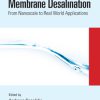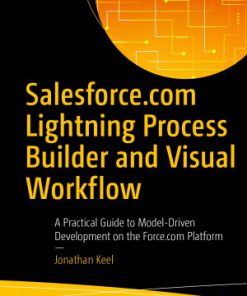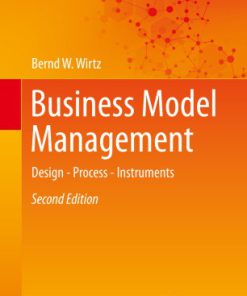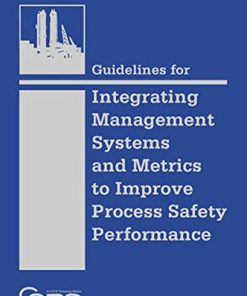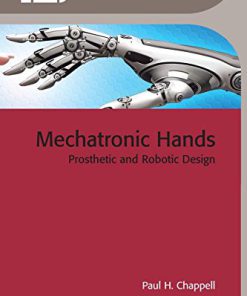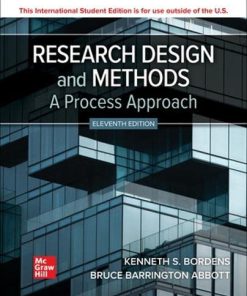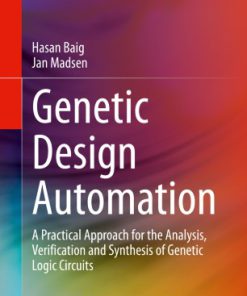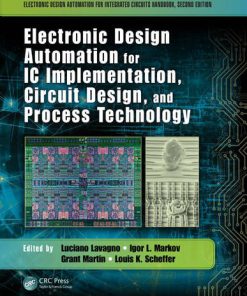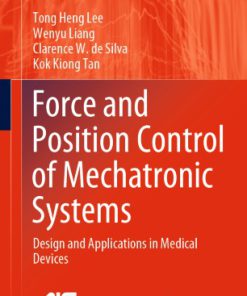Mechatronic Systems and Process Automation Model Driven Approach and Practical Design Guidelines 1st Edition by Patrick Kaltjob 1351248570 9781351248570
$50.00 Original price was: $50.00.$25.00Current price is: $25.00.
Mechatronic Systems and Process Automation: Model-Driven Approach and Practical Design Guidelines 1st Edition by Patrick O.J. Kaltjob – Ebook PDF Instant Download/DeliveryISBN: 1351248570, 9781351248570
Full download Mechatronic Systems and Process Automation: Model-Driven Approach and Practical Design Guidelines 1st Edition after payment.

Product details:
ISBN-10 : 1351248570
ISBN-13 : 9781351248570
Author: Patrick O.J. Kaltjob
The book discusses the concept of process automation and mechatronic system design, while offering a unified approach and methodology for the modeling, analysis, automation and control, networking, monitoring, and sensing of various machines and processes from single electrical-driven machines to large-scale industrial process operations. This step-by-step guide covers design applications from various engineering disciplines (mechanical, chemical, electrical, computer, biomedical) through real-life mechatronics problems and industrial automation case studies with topics such as manufacturing, power grid, cement production, wind generator, oil refining, incubator, etc. Provides step-by-step procedures for the modeling, analysis, control and automation, networking, monitoring, and sensing of single electrical-driven machines to large-scale industrial process operations. Presents model-based theory and practice guidelines for mechatronics system and process automation design. Includes worked examples in every chapter and numerous end-of-chapter real-life exercises, problems, and case studies.
Mechatronic Systems and Process Automation: Model-Driven Approach and Practical Design Guidelines 1st Table of contents:
Chapter 1 Introduction to Mechatronic Systems and Process Automation
1.1 Introduction
1.2 Definitions and Classifications
1.3 Generic Automation System Architecture and Components
1.3.1 Data Processing and Computing Unit
1.3.2 Data Acquisition and Transmission Unit
1.3.3 Electrical-Driven Actuating Unit
1.3.4 Measuring and Detecting Unit
1.3.5 Signal-Conditioning Unit
1.4 Examples of Product and Industrial Process Automation
1.5 Generic Automation System Objectives and Design Methodology
Exercises and Conceptual Problems
Bibliography
Chapter 2 Electrical-Driven Actuating Elements: Modeling and Selection
2.1 Introduction
2.2 Electrical-Driven Actuating Systems
2.2.1 Electromechanical Actuator
2.2.2 DC Motor Dynamics Modeling
2.2.2.1 Self-Excited Series DC Motor
2.2.2.2 Self-Excited Shunt DC Motor
2.2.2.3 Separately Excited DC Motor
2.2.2.4 Compound-Wound DC Motor
2.2.2.5 Permanent Magnet DC Motor
2.2.2.6 Speed Control Methods of DC Motors
2.2.2.6.1 Armature Voltage Control, Va(t)
2.2.2.6.2 Field Control ?
2.2.2.6.3 Armature Resistance Control, Ra
2.2.3 AC Motor Technical Specifications and Dynamics Modeling
2.2.3.1 Induction Motor Dynamics Modeling
2.2.3.2 Speed Control of AC Motors
2.2.4 Stepper Motors
2.2.4.1 Stepper Motor Modeling
2.3 Electrical Motor Sizing and Selection Procedure
2.3.1 Electric Motor Selection
2.3.1.1 Electric Motor Operational Conditions (Duty Cycle)
2.3.1.2 Motion Profile
2.3.1.3 Load Torque Calculation
2.3.1.4 Motor Shaft Torque Calculation
2.3.1.4.1 Procedure of Electrical Motor Selection and Sizing
2.3.1.5 Load Torque–Speed Profile Characteristics
2.3.1.5.1 Four-Quadrant Operation
2.3.1.6 Matching Motor and Load Speed–Torque Curves
2.3.1.7 DC Motor Parameter Estimation
2.3.1.7.1 Estimation of Motor Amplifier Gain, Ka (V/V)
2.3.1.7.2 Estimation of Current Sensor Gain, Ki (V/A)
2.3.1.7.3 Estimation of Back emf Constant, Ke (V·s/rad)
2.3.1.7.4 Estimation of Torque Constant, Kt (N·m/A)
2.3.1.7.5 Estimation of Tachometer Gain, Kv (V·s/rad)
2.3.1.7.6 Estimation of the Armature Resistance, Ra (O)
2.3.1.7.7 Estimation of the Armature Inductance, La (H)
2.3.1.7.8 Estimation of Combined Motor Shaft of Inertia J
2.3.2 Process Dynamics Particularities
2.3.2.1 Summary of Electric Motor Sizing and Selection Procedure
2.3.3 Electric Motor Interface and Accessories
2.3.3.1 Power Source
2.3.3.2 Power Converter
2.4 Modeling of Mechanical Transmission Elements
2.5 Modeling of Electrofluidic Transmission Elements
2.5.1 Electric Pumps
2.5.2 Electric Cylinders
2.5.3 Electric Fans and Blowers
2.5.4 Fluid Flow–Controlled Electric Valves
2.5.4.1 Valve Dynamic Equations
2.6 Modeling of Electrothermal Transmission Elements
2.6.1 Electrical Heating Element Sizing and Selection
2.6.2 Control Requirements of Electrical Heating
2.7 Electrical Binary Actuators
2.7.1 Bistable Actuating Systems
2.7.2 Solid-State-Based Switching Power Electronics
2.7.2.1 Power Diodes
2.7.2.2 Power Transistors
2.7.2.3 Thyristors
2.7.2.4 Logic Integrated Circuit and Programmable Logic Devices
2.8 Solenoids
Exercises and Problems
Bibliography
Chapter 3 Logic Controller Design
3.1 Introduction
3.2 Logic System Design Preliminaries and Methods
3.2.1 Combinatorial and Sequential Logic Systems
3.2.2 Sum of Product and Product of Sum Methods
3.2.3 Karnaugh Maps
3.2.4 Moore and Mealy State Diagrams
3.2.5 Simplified State Diagram
3.2.6 Logic Controller Design Methods
3.3 Process Description and Functional Analysis
3.4 Formal Modeling of Discrete Systems
3.4.1 Process Modeling Using Truth Table and K-Maps
3.4.2 Process Modeling Using Sequence Table Analysis and Switching Theory
3.4.3 Process Modeling Using Simplified State Diagram
3.4.4 Process Modeling Using Sequential Function Chart
3.5 Logic Controller Circuit Design
3.6 Logic Controller Programming Languages
3.6.1 Synchronizing Mechanism of Computer Program Execution
3.6.2 Ladder Diagram
3.6.2.1 Elements of the Ladder Diagram
3.6.3 Function Block
3.6.3.1 Invocation and Incorporation of Functions and Function Blocks
3.6.4 Structured Text
3.6.4.1 IF Statement (IF THEN or IF THEN ELSEIF)
3.6.4.2 CASE Statement (in the Case of Multiple Selections)
3.6.5 Instruction List
3.6.6 Sequential Function Chart
3.7 Wiring Diagram and Automation Project Documentation
3.8 Sizing and Selection of Automation Systems
3.8.1 Memory Structure and Capacity Estimation
3.8.2 Power Supply and I/O Unit
3.9 Fail-Safe Design and Interlocks and Validation Issues
3.9.1 Logic Control Validation (Commissioning)
3.10 Illustrative Case Studies
3.10.1 Fruit Packaging System Using Sequence Table
3.10.2 Fruit Picker Process Design Using Sequence Table
3.10.3 Elevator-Based Motion Process
3.10.4 Automatic Ticket Gate
3.10.5 Mixing Juice Tank
3.10.6 Seaport Gantry Crane
Exercises and Problems
Bibliography
Chapter 4 Process Monitoring, Fault Detection, and Diagnosis
4.1 Introduction
4.2 Requirements for Process Monitoring, Control, and Fault Diagnosis
4.3 Monitoring System Architecture and Components
4.3.1 Process Database Structure Design
4.3.2 Process Data Acquisition and Monitoring Decision Support System
4.4 Operating Model and Fault Management of Processes
4.4.1 Fault Classification, Detection, and Diagnosis Methods
4.4.2 Process Data Reporting
4.4.2.1 Hybrid Control Strategies
4.5 Design Methodology for Monitoring and Control Systems
4.5.1 Requirements for Data Gathering and Process Data Analysis
4.5.2 Requirements for Process Operation Data Reporting via Visualization Systems
4.5.3 Design Methodology of a Monitoring and Control System for Industrial Processes
4.6 Fault-Tolerant Process Design Requirements
4.6.1 Process Interlock Design Principles
4.7 Industrial Case Studies
4.7.1 Bottle Washing Process
4.7.2 Cement Drying Process
4.7.3 Induction Motor Condition Monitoring
4.8 Distributed Control Systems
Exercises
Bibliography
Chapter 5 Sensing and Data Acquisition Elements: Modeling and Selection
5.1 Introduction
5.2 Detection and Measurement Elements: Modeling and Selection
5.2.1 Sensor Classification
5.2.2 Sensor Performance Characteristics
5.2.3 Measurement Error Types
5.2.4 Sensor Sizing and Selection Procedure
5.2.5 Analog Measurement and Detection Instruments
5.2.5.1 Relative Position or Distance Measurement
5.2.5.2 Angular Position Measurement: Resolver and Optical Encoder
5.2.5.3 Velocity Measurement
5.2.5.4 Acceleration Measurement
5.2.5.5 Force Measurement
5.2.5.6 Torque Sensor
5.2.5.7 Flow Measurement
5.2.5.8 Pressure Measurement
5.2.5.9 Liquid-Level Measurement
5.2.5.10 Temperature Measurement
5.2.5.11 Radiofrequency-Based Level Measurement
5.2.5.12 Smart Sensors and Nanosensors
5.2.6 Binary Instruments
5.2.6.1 Binary Device: Electromechanical Limit Switches
5.2.6.2 Binary Device: Photoelectric Sensors
5.2.6.3 Binary Device: RFID-Based Tracking and Detection
5.2.6.4 Binary Device: Pressure Switches
5.3 Signal Conditioning
5.4 Signal Conversion Technology
5.4.1 Digital-to-Analog Conversion
5.4.2 Analog-to-Digital Conversion
5.5 Data Logging and Processing
5.5.1 Computer Bus Structure and Applications
Exercises and Problems
Bibliography
Chapter 6 Data Transmission System
6.1 Introduction
6.2 Network Topology
6.3 Components of Industrial Automation Networks
6.3.1 Typical Transmission Interface and Transmission Media
6.3.1.1 Transmission Support Media
6.3.1.2 RS-232 Interface Standard (EIA232)
6.3.1.3 RS-485 Interface Standard
6.3.1.4 RS-422 Interface Standard
6.3.2 Serial and Parallel Data Communication Format
6.3.3 OSI/ISO Standards
6.4 Constraint Specifications of an Industrial Network
6.5 Communication Protocols for Industrial Automation Systems
6.5.1 4-20mA
6.5.2 HART
6.5.3 Interbus
6.5.4 Modbus
6.5.5 Profibus
6.5.6 DeviceNet
6.5.7 ControlNet
6.5.8 Industrial Ethernet
6.5.9 Serial Synchronous Interface
6.5.10 WorldFIP
6.5.11 Actuator Sensor Interface Bus
6.6 Audit of Industrial Network
6.6.1 Estimation of Industrial Network Latency
6.6.1.1 Modeling of Transmission Media
6.6.1.2 Modeling of Data Fragmentation
6.6.1.3 Estimation of Routing Time
6.6.1.4 Estimation of Blocking Time
6.6.1.5 Estimation of Frame Time
6.6.1.6 Estimation of Propagation Time
6.6.1.7 Estimation of Mean Queuing Time
6.6.2 Modeling of Network Congestion Rate
6.6.3 Modeling of Network Efficiency
6.6.4 Estimation of Industrial Network QoS
6.7 Network Performance Criteria, Benchmarks, and Selection Trade-Off
6.7.1 Efficiency, Average Delay Time Standards, and Data Transmission Rate
6.7.2 Media-Based Consideration and Network Bandwidth
6.7.3 Signal-to-Noise Ratio, Error Rate, and Data Throughput
6.7.4 Response Time and Exceptional Range
6.7.5 Industrial Network Sizing and Selection Methodology
People also search for Mechatronic Systems and Process Automation: Model-Driven Approach and Practical Design Guidelines 1st:
what are mechatronic systems
what is mechatronic systems engineering
mechatronics vs automation
mechatronic systems engineering salary
mechatronic auto solutions
Tags: Mechatronic Systems, Process Automation, Model Driven Approach, Practical Design Guidelines, Patrick Kaltjob
You may also like…
Computers - Programming
Business & Economics - Management & Leadership
Business Model Management : Design – Process – Instruments Bernd W. Wirtz
Computers - Computer Science
Business & Economics - Mathematical Economics
Education Studies & Teaching - Educational Theory
Research Design and Methods: A Process Approach 11th Edition by Bordens 1264169639 9781264169634
Engineering


